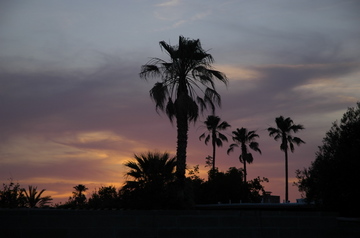1970s houses
I will admit a dirty little secret: I like 1960s and 70s ranch houses. Not all of them, but those few that have a certain style. I like those with low sloping rooflines and big glass windows, simple construction, funky lights and sliding doors, exposed brick fireplaces and single-level floorplans.
That's what we bought. Ours is not the height of 1970s style but it's pretty reasonable. If it had a vaulted living room with shallow angle ceiling and a few more deep overhangs I'd like it even better. To me, these houses, with their little backyards, are just begging for a charcoal grill and a few neighbors to come over in the evening.
As with all small peculiarities and kinks, I'm not alone. So many people are interested in the funky potential of these ranches that a niche quarterly has sprung up (much like Airstream Life magazine), called "Atomic Ranch." People are finding ranches made in the high style and fixing them up to a level of class that they never had originally.
One nice thing about the ranches is that they are dead simple in their construction. Ours is an example, with slab-on-grade foundation and no attic. Of course, the downsides of the era are numerous: very little insulation, single-pane windows that are difficult to duplicate, cheezy sliding doors, often small bathrooms, and perhaps aluminum wiring.
Our house was built in 1971, in a neighborhood that was once on the outskirts of Tucson and regarded as the cutting-edge in subdivisions at the time. The builder insisted on all the first-class amenities, such as underground utilities, service alleys, a divided boulevard leading in, palm trees everywhere, carports & garages, paved streets, and houses built only of brick, adobe block, stucco, or redwood.
A neighbor popped over today to introduce himself and tell us a little about the area. Reputedly, an heiress to the Zenith fortune lived in the neighborhood. A famous mobster lived here. Peter Fonda used to visit somebody here, and there's a story about him riding a motorcycle on the roof. True? I can't tell but it's great to have some history to bring the place to life for us.
I like 1970s Airstreams too. Our 1977 Argosy was a really wonderful trailer to renovate and own. Perhaps it's my bias as a child of the 1970s, but I see a lot of good in that era that is overlooked. People tend to focus on the green shag rugs and disco as reasons to dismiss the 70s. As a result, vintage objects from the 70s are plentiful and cheap. That includes Airstreams and Argosies, as well as houses. It's an era where you can get a lot of value for your dollar if you shop carefully.
Tonight Eleanor insisted on grilling things that nature did not intend to be grilled. Chicken, OK. Asparagus, onions and potatoes, sure. But strawberries, bananas, grapefruit and pineapple? Well, the pineapple and grapefruit came out OK, but bananas and strawberries don't appreciate being grilled. Still, with a dressing, it made for a very interesting salad. We ate it all sitting in the back yard and watching the sunset, while Tucson cooled down into the mid-80s at 8 o'clock.


Comments
The house style you described today sounds like the "Mid-century Modern" that was a popular contemporary design from the 1950'-1970's. They were prolific in the suburbs of metropolitan cities in their day and now find themselves to be swallowed up by urban sprawl resulting in urban enclaves of most major cities. Not only are they popular they are as highly sought after as Airstreams of the same era. They offer the clean, modern aesthetic that today's youth, and many baby boomers, can't find in typical developments in the 'burbs or even in anything other than the priciest of custom neighborhoods. Even with infill lots in established neighborhoods, neighborhood architectural review committees/covenants and historic zoning codes/regulations won't allow contemporary architecture to be built so these little gems of our architectural history fill a void for modern architecture.
Posted by: Tom | May 15, 2007 02:36 PM